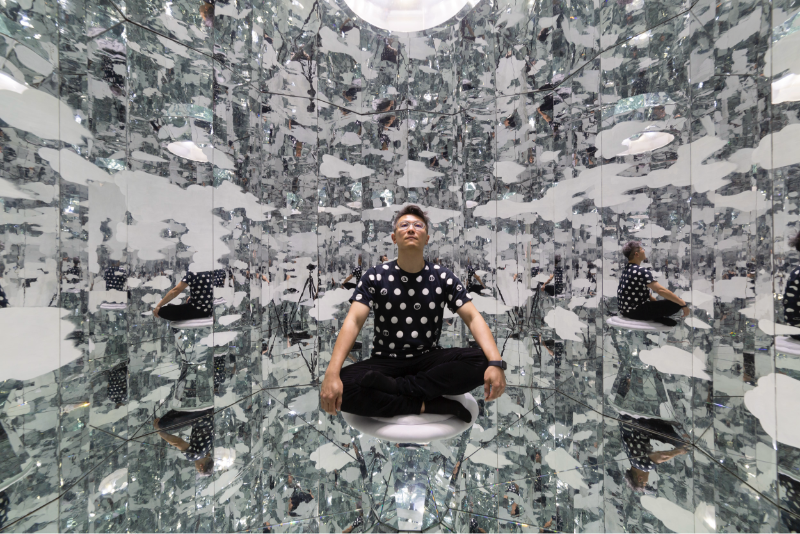In his kinetic objects and interactive environments, Nick Dong combines the simple, fractal serenity of Buddhist design with the quirky warmth of Victorian curio cabinets, as well as a refined yet theatrical sense of surprise. Across a handful of discrete objects and three walk-in installations, “Divine Immersion” crescendos along a deliberate path, engineered for impact on the mood and psyche. Dong speaks about the need for philosophical if not overtly spiritual forms of communication, as we as a society and as individuals emerge from a prolonged period of danger and isolation—and it is his intention with this exhibition to offer such transformation to all who desire it. At certain transcendent moments, he succeeds.
The first room appears as if a domestic salon took a trip through the looking glass to the Far East. Pieces of hearty furniture—a dining room chair, a vanity table, a grandfather clock, a side table—have been interfered with in the most intriguing ways. On the seat of the chair three small sculptural objects rest, white biomorphic shapes covered in ink-drawn scrimshaw patterns. Moved by unseen forces, the objects slowly spin and shimmy. The gentle surrealism piques a slightly altered state of mind, so it is not unexpected when the delicate flame-like petals of the golden sphere on Vanity (2021) start to sway. The rest of the sculptures softly perform; the viewer has entered a seemingly familiar world where bits of ordinary magic are not only possible but expected.
The one-person-at-a-time immersive chamber Heaven (2019) is an analog spectacular. It’s tempting to think about Kusama’s “Infinity Rooms,” but at the same time, this hand-made environment is not really about illusion. There’s no “How did he do it?” It’s plain to see how it’s made of metal leaves, ring lights and mirrors, and that is the point. Like the sculptures before and the other room-sized works ahead, Heaven is both luxuriously gorgeous and grounded in the familiar. Dong’s talent for elevating commonplace materials into vessels of magic, mindfulness and evolution is not only rather awe-inspiring, but contains a rich set of metaphors as to how each of us, as we go about our daily lives, might choose to be aware of the potential splendor of everything we touch and take for granted.
After a spellbinding room of viewer-activated singing meditation bowls, the last piece is the most operatic, with the energy of a finale. Becoming Horizon (2021) is essentially a metal mesh suspended between four posts, with lights, and a silver dancing flicker shape in the center. But its effect—below the “horizon” is an opulent cascade of golden light, falling and accumulating like snowflakes or autumn leaves; above, a sparkling nebula of gathering clouds. Its artifice being apparent in no way lessens, and in fact heightens, the enchantment. The artist promised an energy realignment, a sense of peace. That’s a lot to ask of sculpture, no matter how lovely. What it does deliver in spades is pure delight—what you do with your improved mood is entirely up to you.


